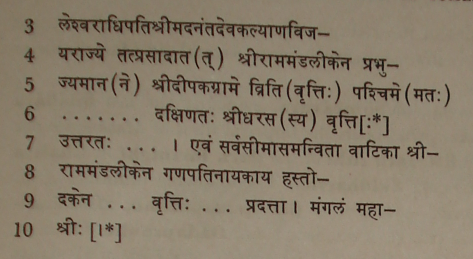|
The Indian Analyst
|
North Indian Inscriptions |
INSCRIPTIONS OF THE SILAHARAS OF NORTH KONKAN
TRANSLATION ..Hail ! In the Śaka year 1176, the (cyclic) year Ānanda, on the 8th day (i.e. tithi) of the dark fortnight of Āshāḍha, on this day, here, during the beneficial and victorious reign of the Mahāmaṇḍalēśvarādhipati, the illustrious Anantadēva (II), adorned with all royal titles, in the famous Dīpaka village enjoyed by the illustrious Rāma Maṇḍalīka, the vāṭikā (orchard) with all its boundaries stated as follows‒on the west, the vṛitti (of) . . . .(on the east) . . . . . on the south, the field of Śrīdhara, on the north . . . . ‒has been granted by the illustrious Rāma Maṇḍalīka as a vṛitti (means of subsistence) to Gaṇapati Nāyaka with the pouring out of water on (his) hand. ..May there be happiness and great prosperity !
No. 38 : PLATE LXXV ..THE stone bearing this inscription was found at Rānvaḍ near Uraṇ in the Kolābā District. It was first very briefly noticed by Pandit Bhagvanlal in the Bombay Gazetteer (old ed.), Vol. I, part ii, p. 21, n. 1. He, however, read the date wrongly as 1171[1]. It was corrected by Dr. A.S. Altekar in the Indian Culture, Vol. II, p. 431. The inscription was first edited, without a facsimile, by Dr. H.D. Sankalia and S.C. Upadhyaya in the Epigraphia Indica, Vol. XXIII, pp. 278 f. Subsequently Dr. M.G. Dikshit edited it with an indifferent facsimile in Marāṭhī Saṁśōdhana Patrikā, Vol. VI, No. 4, pp. 13 f. It has been included with a good facsimile by Dr. S.G. Tulpule in his Prāchīna Marāṭhī Kōrīva Lēkha, pp. 156 f. It is edited here from an estampage kindly supplied by the Chief Epigraphist, and the plate accompanying Dr. Tulpuleâs article. .. âThe stone measures 3’ (91.44 cm.) by 1’ 6” (45.72 cm.). The inscribed portion is 1’ by 1’ 5”, and contains 11 lines of writing, the average size of the letters being 3/4”. Below this, is an ass-sculpture differing slightly in the position of the woman from those noticed before[2], carved in low relief in a rectangle (18” by 11”). At the top above the inscription, are the Sun and the Moon and between them a double kalaśa.[3]â .. The characters are of the Nāgarī alphabet. It is noteworthy that the initial i still retains its old form (see ity-ādi, line 4), and dh has a clear horn on the left (see Sandhivigrahi, line 4).
..
The language is Sanskrit in the initial portion, and Marathi in the formal portion. The
[1] In his List of Inscriptions of Southern India (p. 56), Kielhorn read the year as Ś. 1181, but expressed his inability to give the date in full. The figure for 8 is slightly more developed than that in the Chipḷūṇ and Bassein
stone inscriptions of Mallikārjuna, and the Parēḷ stone inscription of Aparāditya II (Nos. 28 and 29,
above). In some of these cases it was misread before.
|
|||||||||||||||||||||||||||||||||||||||||||||||||||||||||||||||||||||||||||||||||||||||||||||||||||||||||||||||||||||
| > |
|
>
|








